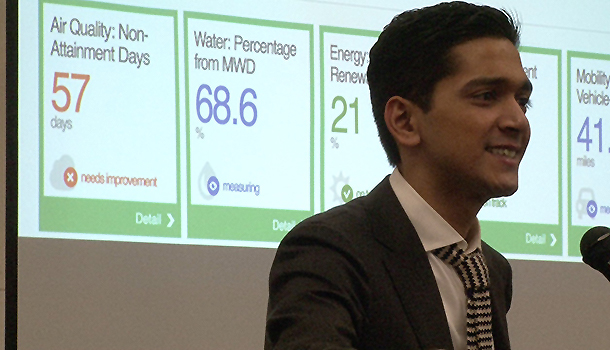
City of L.A.’s Chief Data Officer Abhi Nemani (Photo Credit: John Guenther)
In a perfect world, all governmental agencies would have an open data portal that is easy to access and analyze. This would allow citizens to find out how their tax dollars are being spent, from finding when the last time the water main on their street was replaced to seeing the latest health inspection results of their favorite restaurant. Open data leads to government transparency which eventually leads to a better quality of life for its citizens, say advocates.
But we are far from that world, and in fact, many cities are in need of robust standards to help them create and maintain their open data initiatives. Those are the findings of a report by Open Data LA, a joint project of the USC Annenberg Center on Communication Leadership & Policy and USC Sol Price School of Public Policy.
Lead researcher and USC faculty member Dana Chinn found that a new framework needed to be created because there are a lot of misconceptions about open data.
“I really fear that the general public is sort of reducing open data to hackathons and technology-based meet-ups,” said Chinn.
And while more and more governments are releasing previously inaccessible data, it can sometimes be difficult to read and use, defeating the purpose of releasing it. On top of that, data work can be costly and the results can vary widely, as shown in a recent KPCC analysis.
Chinn wanted to find out how cities and public agencies can take their open data efforts to the next level to be more effective and efficient, asking “How do you get to the benefits of government transparency and better services?”
Currently, agencies and advocates have relied on two sets of criteria to measure open data initiatives, the U.S. City Open Data Census Rating and the financial transparency criteria developed by California Public Interest Research Group (CALPIRG). The new report suggests that the two methods of measuring quality and “openness” should be revised and blended.
The new framework in “The State of Open Data in Los Angeles County: A Framework” ranks each city’s level of leadership and data. According to the report, city leadership that earns a “strong” rating has an open data executive policy or city legislative action, a full-time open data staff and dedicated funding for open data. Quantity, quality and accessibility would be the criteria for the data itself.
Then researchers placed eight cities within the County into the new framework. Of those cities Los Angeles ranked high because it has a dedicated Chief Data Officer and an executive directive to promote transparency and accountability. West Hollywood and Culver City also ranked high with access to data, but needed more leadership.
“Really, the fastest way and to make sure that the open datasets are sustainable is to have that official executive order or something that would put it into law,” said Chinn.
Most cities currently maintain open data on a voluntary basis and Chinn also noted that two state bills currently being discussed, AB 169, which would require agency open data be easily retrievable and searchable, and SB 272, which would require cities to create data “inventories,” are a good start.
“I would love to see something that says ‘all cities must devote X percent of their budget to open data’ — funds that could not be diverted to any other thing,” said Chinn.
The next phase of Open Data LA’s report will focus on how journalists can help further develop the new framework. “The way I came to see it was that our framework can be classified as journalism in the public interest,” said Chinn. “Journalism’s role is not only as a government watchdog, it’s also to engage citizens to understand what open data success is and how important open data is to government transparency and accountability.”

